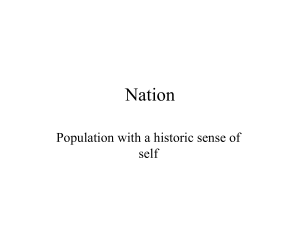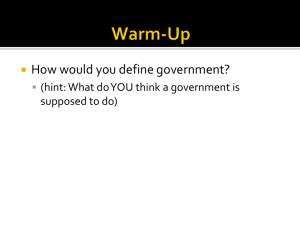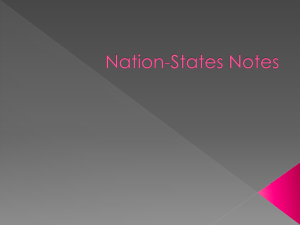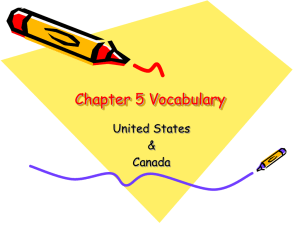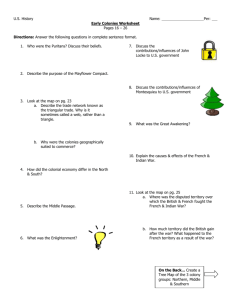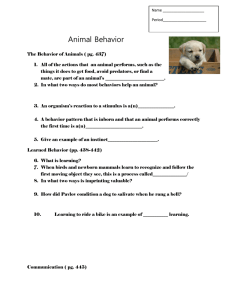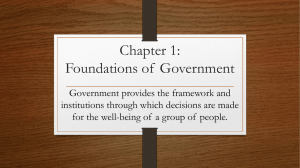Support to Civil Administration Chapter 11
advertisement
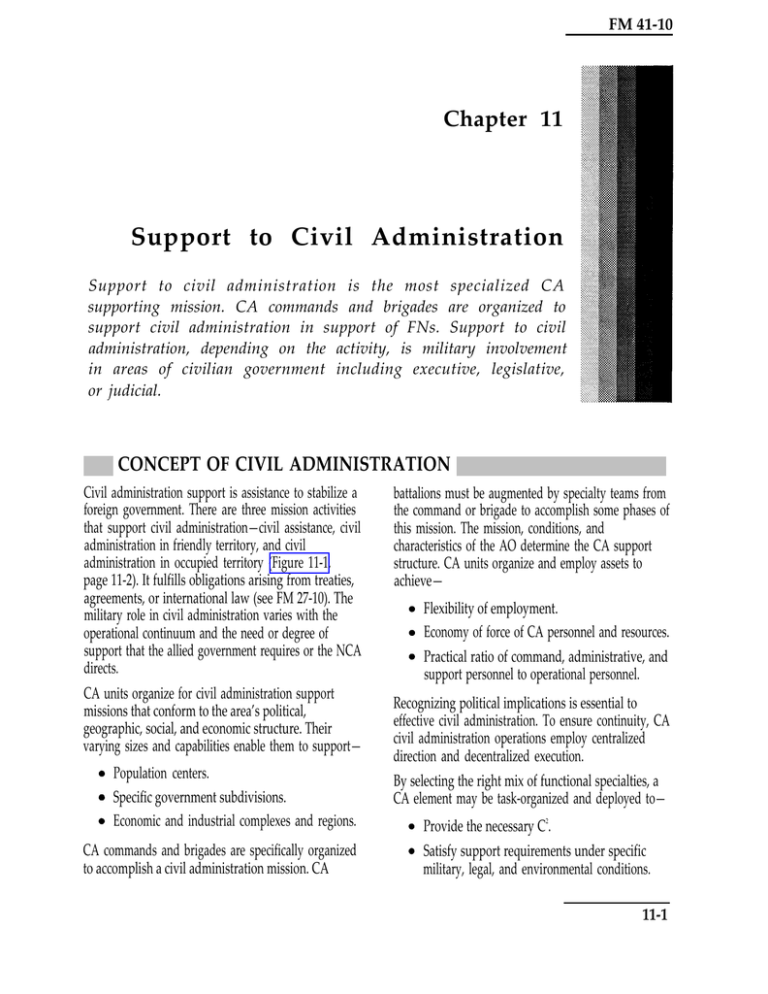
FM 41-10 Chapter 11 Support to Civil Administration Support to civil administration is the most specialized CA supporting mission. CA commands and brigades are organized to support civil administration in support of FNs. Support to civil administration, depending on the activity, is military involvement in areas of civilian government including executive, legislative, or judicial. CONCEPT OF CIVIL ADMINISTRATION Civil administration support is assistance to stabilize a foreign government. There are three mission activities that support civil administration—civil assistance, civil administration in friendly territory, and civil administration in occupied territory (Figure 11-1, page 11-2). It fulfills obligations arising from treaties, agreements, or international law (see FM 27-10). The military role in civil administration varies with the operational continuum and the need or degree of support that the allied government requires or the NCA directs. CA units organize for civil administration support missions that conform to the area’s political, geographic, social, and economic structure. Their varying sizes and capabilities enable them to support— Population centers. Specific government subdivisions. Economic and industrial complexes and regions. CA commands and brigades are specifically organized to accomplish a civil administration mission. CA battalions must be augmented by specialty teams from the command or brigade to accomplish some phases of this mission. The mission, conditions, and characteristics of the AO determine the CA support structure. CA units organize and employ assets to achieve— Flexibility of employment. Economy of force of CA personnel and resources. Practical ratio of command, administrative, and support personnel to operational personnel. Recognizing political implications is essential to effective civil administration. To ensure continuity, CA civil administration operations employ centralized direction and decentralized execution. By selecting the right mix of functional specialties, a CA element may be task-organized and deployed to— 2 Provide the necessary C . Satisfy support requirements under specific military, legal, and environmental conditions. 11-1 FM 41-10 CIVIL ASSISTANCE CA units support civil assistance in the aftermath of natural or man-made calamities or disasters. Based on military necessity, a commander may begin civil assistance within his assigned AOR to— Maintain order. Provide potential life-sustaining services. Control distribution of goods and services. Civil assistance differs from the other two activities of civil administration because it is based on the commander’s decision. It provides short-term military support to an established government or populace and does not incur a long-term U.S. commitment. It also provides support at the subnational level to a U.S.-recognized government. CA units support civil assistance by— Determining the capabilities of the existing civil administration. Developing plans to reinforce or restore civil administration. Coordinating civil assistance plans with HN, U.S., and allied agencies. Arranging for transfer of authority. CIVIL ADMINISTRATION IN FRIENDLY TERRITORY U.S. CINCs support governments of friendly territories. Local authorities may request the U.S. military to perform basic government functions during disasters or war. As situations stabilize, the functions performed by the armed forces return to civilian agencies. The transition normally is gradual and require detailed, long-range planning. CA staff officers review civil administration guidance provided by higher authority to identify the military implications 11-2 of support to civil administration. The NCA must direct that CMO conducted in conjunction with this mission support the CINC’s regional security strategy. The damage or disruption to a nation’s government, economy, infrastructure, or social institutions may exceed its ability to effectively deal with the situation. In these cases, the government may request help through diplomatic channels from the United States. FM 41-10 If a military commander receives such a request, he forwards it to the COM. The COM communicates the FN’s request for civil administration support through appropriate DOS and DOD channels. The theater CINC tasks the TA commander to provide the CA personnel for the mission. If CA assets are not available in theater, the theater CINC requests support from the JCS. Based on directions received from the President through the DOS, the COM negotiates a civil administration support agreement with the nation’s government. This agreement outlines the nature and extent of the support needed. It defines the limits of authority and liability of U.S. military personnel. It also defines the CA relationships that will exist. The CINC’s legal staff coordinates, approves, and reviews this process. A formal agreement is desirable before committing U.S. personnel. However, if the COM and the theater commander believe it is necessary and in the best interests of the United States, civil administration support missions can begin before a formal agreement. However, as soon as possible, there must be some form of agreement between the FN and the United States. This agreement establishes the extent, goals, and expected duration of the support mission. The CINC allocates resources based on the— Requirements the COM identifies. Damage and disruption suffered by the economy and institutions of the area. General welfare of the people. CA assets available. The level of support rendered is tailored to meet the needs of the existing situation. In no case will it exceed— The FN’s request for help. Applicable international treaties and agreements. Limitations imposed by the law of land warfare. Regardless of the circumstances under which U.S. forces are employed, international law obligates the commander concerning civilian populations, governments, and economies. Requirements are usually specified in agreements or the law of land warfare. Treaty obligations are set forth in the Hague Conventions of 1907, the four Geneva Conventions of 1949, and other documents. FM 27-10, DA Pam 27-1, and other service publications explain the commander’s legal obligations. The nation’s people and government must be willing to accept the support. It must complement the experience and expectations of the supported agencies. This support should be temporary. It ends as soon as the government can resume normal activity. Many PVOs and national and international agencies can provide aid to a devastated nation. The CA staff or USG agencies should contact and encourage these agencies to participate. The CA staff is well-suited to provide coordination and liaison in these situations. The U.S. commander cannot compromise a government’s sovereignty. If disputes develop between government authorities and CA personnel, CA personnel will submit the problem through the chain of command for resolution. The senior U.S. commander maintains liaison with U.S. diplomatic representatives to ensure maximum efficiency and unification of policy. An executive order will cover the scope of authority and provide procedural guidance. Civilian unrest associated with disasters or combat can hinder effective employment of U.S. forces. Under such conditions, CA tasks include any or all of the functional tasks. Equally important are civil-military relationships in peace when commanders have neither authority nor jurisdiction over civilians. At times the commanders may even share authority over their own installations and personnel with local civil authorities. Trained CA staff officers and personnel can accomplish efficient liaison and negotiation. 11-3 FM 41-10 CIVIL ADMINISTRATION IN OCCUPIED TERRITORY Situations occur when military necessity or legitimate directives require the Army to establish a temporary government in an occupied territory. The NCA must direct establishment of civil administration to exercise temporary executive, legislative, and judicial authority in occupied territory. The U.S. forces will only assume control prescribed in directives to the U.S. commander. Within its capabilities, the occupying power must maintain an orderly government in the occupied territory. This type of operation differs from the other two activities of civil administration in that it is imposed force. The administered territory is under effective U.S. military control. The U.S. military’s goal is to establish a government that supports U.S. objectives and to transfer control to a duly recognized government as quickly as possible. The U.S. military will identify, screen, and train reliable civilians to ease this transfer. Even with the use of local civilians, the occupying forces still retain the power to exercise supreme authority. Granting authority to civilian government officials does not of itself terminate the Army’s responsibility in the occupied territory. The goal of U.S. civil administration of an occupied territory is to create an effective civil government. This government should not pose a threat to future peace and stability. CMO support to civil administration of an occupied territory should emphasize that— The populace receives responsive and effective government services. The populace is able to obtain essential goods and services. The measures taken enhance the social and economic well-being of the occupied territory. The system of control furthers U.S. political objectives. Law and order prevail. Restoration, rehabilitation, and development take place in the occupied territory’s social institutions and economic system. An orderly and efficient transition occurs from civil administration to civil government. 11-4 The country and people are as well off at the end of civil administration as at the onset of occupation. The obligations of international law and treaties are met. Human rights abuses against collaborators, minority groups, discriminated social classes, or individuals must be prevented. The commander of an occupying force has the right, within the limits set by international law, U.S. laws, treaties, and the UCMJ, to demand and enforce law and order in an occupied area to accomplish his mission and properly manage the area. In return for such obedience, the inhabitants have a right to freedom from unnecessary interference with their individual liberty and property rights. Subject to the requirements of the military situation, commanders must observe the principle of governing for the benefit of the governed. Occupied hostile territory is an area the United States has taken possession of (through force of arms) with the intent to keep it from enemy control. Possession does not require the presence of troops in all areas of the occupied country. The occupying force must, however, be able to quickly deploy to any area within the territory to enforce its authority. The number of troops required to occupy a territory depends on the— Degree of resistance to the occupation. Size of the area and the nature of the terrain. Population density and distribution. Level of development in the area. The head of an established civil administration system is the civil administrator, often called the military governor. The administrator is a military commander or other designated person who exercises authority over the occupied territory. The civil administration’s structure may develop in one of the ways described below. The occupying power may allow the existing government structure to continue under its control and supervision. This arrangement does not mean the occupying power approves of the existing regime or condones its past actions. It represents the easiest basis for developing a functioning government on short FM 41-10 notice, since it is already in place. The occupying power may elect to retain all public officials or, for political or security reasons, may replace all or selected personnel with other qualified people. Programs directed toward effecting political reform, strengthening government agencies and institutions, and developing self-government are carried out as necessary. In some cases, the occupying power may find it necessary to reorganize, replace, or abolish selected agencies or institutions of the existing government. Replacing the existing government and building a new structure is the most drastic COA. The cccupying power should adopt this COA only if the old regime has completely collapsed or is so hostile or poses such a threat to peace and stability that its continued existence cannot be tolerated. The occupying power must obey the existing laws, but in many cases, it may have to change the existing laws. International law is quite specific about requirements. It must meet these requirements when changing civil law in an occupied territory. Consult with an international law specialist and review FM 27-10 and other texts on the law of land warfare for further information. 11-5
